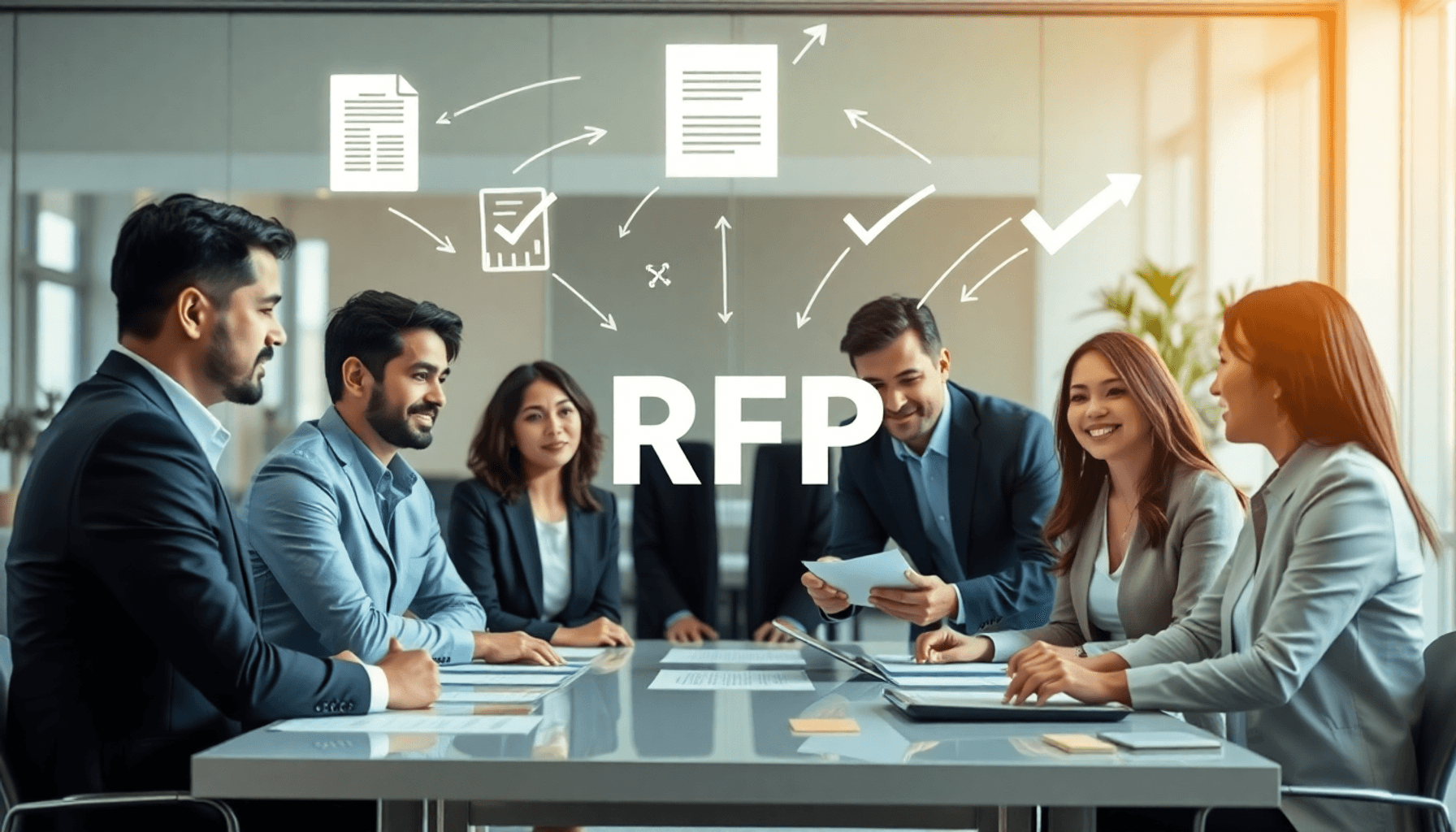Introduction
In today’s fast-paced business world, procurement transformation is crucial. Organizations are under more pressure than ever to make their procurement processes better. This means using technology and innovative strategies to become more efficient, save money, and build better relationships with suppliers.
This article will cover several important topics related to procurement transformation:
- The need for transformation: Understanding the challenges of traditional procurement.
- Digital transformation: Exploring how technology reshapes procurement practices.
- Data analytics: Utilizing insights for optimized procurement operations.
- Supplier relationships: Building strong partnerships for mutual success.
- Automation: Streamlining tasks to increase transparency and efficiency.
- Compliance and risk management: Ensuring adherence to regulations throughout the procurement journey.
- Continuous improvement: Fostering a culture that sustains long-term success post-transformation.
By reading this article, you’ll discover effective ways to transform your procurement operations. Here are some examples of how this knowledge can be applied:
- Maximizing federal grant funding for nonprofits can be an essential part of your procurement strategy.
- Boosting employee morale with break room supplies can enhance supplier relationships by fostering a positive work environment.
- Focusing on essential PPE for airborne precautions in healthcare is crucial for compliance and risk management in the procurement process.
- Myth-busting GPOs can provide clarity on the intricacies of group purchasing organizations.
- Incorporating frugal living practices can significantly contribute to cost reduction efforts in your procurement operations.
Why Procurement Needs to Change
Procurement operations often face significant challenges that hinder efficiency and effectiveness. Common issues include:
- Manual Processes: Reliance on paperwork and spreadsheets can lead to errors and delays.
- Lack of Visibility: Limited access to real-time data creates obstacles in decision-making.
- Supplier Management: Difficulty in assessing supplier performance can result in suboptimal partnerships.
These procurement inefficiencies directly impact costs and productivity. For instance:
- Increased Expenses: Inefficient processes can inflate operational costs, leading to budget overruns.
- Lost Opportunities: Slow response times may cause missed savings and growth prospects.
Transforming procurement operations becomes essential to maintain competitiveness in a fast-paced market. Key reasons for this transformation include:
- Cost Reduction: Streamlined processes allow for better negotiation and purchasing practices, directly impacting the bottom line.
- Enhanced Agility: Adopting modern technologies enables quicker responses to market changes, ensuring your organization remains agile.
- Strategic Alignment: A restructured procurement function supports broader business goals, promoting collaboration across departments.
Focusing on addressing these operational challenges positions organizations to thrive in today’s dynamic business landscape. For example, companies can succeed with limited resources by optimizing processes and leveraging networks. Furthermore, understanding diversity, equity, and inclusion (DEI) in the workplace can also enhance supplier management by fostering better relationships. It’s crucial to be aware of certain procurement terms that may hinder communication, as clear communication is key to successful procurement. Lastly, understanding the difference between purchasing groups and group purchasing organizations can further streamline procurement processes.
Digital Transformation in Procurement
Digital transformation has become a critical component in enhancing procurement performance. In an era where efficiency and responsiveness define competitive advantage, organizations must leverage digital technologies to streamline processes, reduce costs, and improve service delivery. Chief Procurement Officers (CPOs) recognize the urgency of adopting innovative technologies to stay ahead in the evolving market landscape.
Insights from CPOs on Technology Adoption
CPOs are increasingly vocal about the necessity of embracing digital tools. They emphasize the following benefits:
- Enhanced Efficiency: Automation of routine tasks minimizes delays and errors.
- Data-Driven Decisions: Access to real-time data analytics fosters informed decision-making.
- Improved Collaboration: Digital platforms enable better communication with suppliers and stakeholders.
Digital tools not only enhance operational capabilities but also contribute to a more responsive procurement function. This responsiveness is crucial as businesses adapt to fast-changing market demands.
Key Digital Technologies Driving Change in Procurement
Several key digital technologies are reshaping the procurement landscape:
Artificial Intelligence (AI)
AI applications have made significant strides within procurement operations. Key areas include:
- Predictive Analytics: AI can forecast demand trends, allowing organizations to optimize inventory levels and procurement strategies.
- Supplier Risk Assessment: AI tools analyze supplier performance metrics, enabling organizations to identify potential risks and make proactive adjustments.
These applications result in increased accuracy and reduced uncertainty in procurement planning.
Robotic Process Automation (RPA)
RPA technology offers profound benefits by automating repetitive tasks. The advantages include:
- Faster Turnaround Times: RPA accelerates processes like order processing and invoice management, leading to quicker fulfillment.
- Reduced Manual Errors: Automation decreases human error rates, enhancing overall accuracy in transactions.
Implementing RPA allows teams to focus on strategic activities rather than routine administrative work.
Blockchain Technology
Blockchain introduces a new level of transparency and security throughout the procurement process. Its impact includes:
- Secure Transactions: Blockchain ensures that all transactions are recorded immutably, reducing fraud risks.
- Enhanced Traceability: Organizations can track the origin and journey of products through the supply chain, promoting ethical sourcing practices.
By utilizing blockchain technology, organizations can build trust with stakeholders while ensuring compliance with regulations.
Benefits of Leveraging Digital Tools for Improved Service Delivery
The integration of digital technologies yields numerous benefits for service delivery within procurement functions:
- Cost Savings: Automating processes reduces labor costs associated with manual tasks.
- Increased Agility: Organizations can quickly adapt their procurement strategies based on real-time data insights.
- Greater Supplier Engagement: Enhanced communication channels foster stronger relationships between buyers and suppliers, leading to better collaboration.
These advancements are essential for transforming procurement operations into more agile, efficient entities capable of meeting modern challenges head-on. As companies like Hubzone Depot LLC continue to innovate their practices through these technologies, they set benchmarks that others in the industry aspire to reach.
Embracing digital transformation is no longer an option but a necessity for organizations aiming for long-term success in their procurement functions. This transformation not only involves adopting new technologies but also requires a shift in mindset towards continuous learning and adaptation as illustrated by Frank Corris’s transformative journey in Mastering Procurement Through Learning & Adapt
Leveraging Data Analytics for Procurement Optimization
Data analytics plays a crucial role in modern procurement, offering organizations the ability to gain real-time visibility into their operations. By utilizing advanced analytics tools, procurement teams can:
- Monitor spending trends: Understand where funds are allocated and identify areas for potential savings. This can be particularly useful when leveraging drastic cost reduction through collective spend.
- Identify compliance issues: Ensure adherence to regulations and internal policies, reducing the risk of costly penalties.
The integration of data-driven insights empowers organizations to manage risks effectively. For instance, predictive analytics can highlight potential disruptions in supply chains, enabling proactive measures. Additionally, procurement teams can leverage these insights to uncover cost-saving opportunities by analyzing historical purchasing behavior and supplier performance.
Strategic sourcing decisions become more informed through data analytics. By evaluating supplier data and market trends, organizations can negotiate better contracts and foster stronger supplier relationships. This is especially relevant when considering effective sourcing strategies, which can also be adapted for procurement purposes.
Adopting a data-centric approach not only enhances operational efficiency but also aligns procurement activities with organizational goals. As businesses strive for agility and competitiveness in their procurement functions, the implementation of data analytics stands out as an essential component for successful optimization.
It’s important to note that strategic sourcing should not be confused with category management; both have distinct roles in procurement strategy.
For those managing a smaller scale operation such as a one-person procurement function, these data-driven strategies can still be effectively applied to optimize processes.
Lastly, looking towards the future, understanding procurement engineer salary trends could provide valuable insights for professionals planning their career path in this field.
Building Strong Supplier Relationships for Successful Procurement Transformation
Strong supplier relationships are vital in achieving operational success following procurement transformation. When businesses prioritize collaboration with suppliers, they unlock numerous benefits that enhance productivity and reduce costs.
Key Strategies for Effective Vendor Management
- Supplier Segmentation: Categorizing suppliers based on their strategic importance allows organizations to tailor their engagement strategies. High-value suppliers receive more attention and resources, fostering deeper partnerships. This approach is a crucial part of tail spend management.
- Performance Assessments: Implementing structured evaluation processes helps in monitoring supplier performance. Regular reviews provide insights into areas for improvement, aligning both parties towards common goals. To ensure quality and reliability, consider these tips for maximizing supplier performance.
- Collaborative Innovation: Encouraging open communication channels can lead to joint problem-solving initiatives. By involving suppliers in the innovation process, companies can leverage external expertise to enhance product offerings or streamline operations. Transparent supplier communication is essential in building trust and driving business growth.
Strong relationships built on trust and mutual benefit create a foundation for long-term success. Engaging suppliers as partners rather than mere vendors cultivates an environment ripe for collaboration and shared growth. The impact of these relationships extends beyond immediate cost savings, influencing overall business resilience and adaptability in a competitive landscape.
For more personalized advice on building these essential supplier relationships, feel free to contact us.
Automation: A Key Enabler of Efficiency and Transparency in Procurement Processes
Procurement automation plays a crucial role in transforming procurement operations. By streamlining various tasks, organizations can achieve significant improvements in efficiency and transparency. Key benefits include:
1. Bid Submissions
Automated systems simplify the process of collecting and evaluating bids, reducing the time spent on manual reviews.
2. Contract Management
Automating contract creation and tracking ensures compliance, minimizes risks, and provides easy access to important documents.
3. Quality Control Checks
Implementing automated quality control processes enhances product reliability while decreasing the likelihood of errors.
4. Payment Tracking
Automation allows for real-time monitoring of payment processes, leading to timely transactions and improved supplier relationships.
These enhancements not only reduce operational costs but also increase productivity across procurement teams. As organizations embrace technology, they position themselves to adapt quickly to market changes while fostering a culture of continuous improvement. Investing in procurement automation aligns with broader digital transformation goals, creating a more agile and responsive supply chain.
To further enhance these benefits, exploring procurement optimization strategies can provide additional value. Additionally, organizations can unlock exclusive membership benefits that could further streamline their procurement processes.
Ensuring Compliance and Managing Risks Throughout the Procurement Journey
Establishing strong compliance frameworks is crucial for navigating the complex world of procurement operations. These frameworks help reduce risks associated with non-compliance, which can result in severe financial penalties, damage to reputation, and disruptions in supply chains.
Key elements of effective compliance include:
- Adherence to Regulatory Requirements: Ensure alignment with local, state, and federal regulations. Regular reviews of compliance policies will keep your organization informed of any changes.
- Training and Awareness Programs: Engage employees at all levels through training sessions that emphasize the importance of compliance and ethical procurement practices.
- Regular Audits: Conduct audits to assess adherence to compliance policies and identify areas for improvement. This proactive approach helps in reducing potential risks before they worsen.
- Vendor Compliance Checks: Implement processes to evaluate suppliers’ adherence to relevant regulations. This ensures that your supply chain remains compliant and minimizes risk exposure.
By prioritizing compliance in procurement operations, organizations can create a more transparent process. This not only improves operational efficiency but also builds trust among stakeholders.
Continuous Improvement Framework for Sustaining Long-Term Success in Transformed Procurement Functions
Establishing a culture of continuous improvement within the procurement team is essential for long-term success. Implementing a continuous improvement process can significantly enhance efficiency and adaptability. Here are key steps to consider:
1. Define Clear Objectives
Set specific, measurable goals aligned with the organization’s vision. These objectives guide the team’s efforts and provide benchmarks for progress.
2. Encourage Open Communication
Foster an environment where team members feel comfortable sharing ideas and feedback. Regular discussions can unveil opportunities for improvement.
3. Implement Training Programs
Invest in training that focuses on new technologies, industry best practices, and effective procurement strategies. This keeps the team informed and engaged.
4. Utilize Performance Metrics
Establish KPIs to evaluate performance regularly. Metrics such as cost savings, supplier performance, and time efficiencies help identify areas needing attention.
5. Celebrate Achievements
Recognize individual and team contributions toward achieving improvement goals. Celebrating successes motivates ongoing commitment to the process.
By embedding these practices into the procurement function, organizations can ensure that their transformation efforts remain relevant and effective, driving sustained growth and innovation.
Case Study: Piramal’s Journey Towards a Digitally-Driven and Agile Procurement Function
Piramal has embraced a transformative approach in procurement operations, leveraging digital technologies such as AI and Robotic Process Automation (RPA). Key initiatives include:
- AI Implementation: Utilizing predictive analytics to forecast demand, enabling smarter inventory management.
- RPA Adoption: Streamlining repetitive tasks like invoice processing, which has significantly reduced turnaround times and minimized manual errors.
- Supplier Risk Assessment: Integrating AI tools for comprehensive supplier evaluations, enhancing risk management strategies.
These efforts have positioned Piramal as a leader in procurement transformation. The strategic focus on technology not only improves efficiency but also drives cost-effectiveness, aligning with the company’s goal of maintaining competitiveness in an evolving market landscape. As Piramal continues its journey, insights from this case study can serve as inspiration for other organizations seeking similar transformations.
FAQs (Frequently Asked Questions)
What is procurement transformation and why is it significant in today’s business landscape?
Procurement transformation refers to the process of rethinking and redesigning procurement operations to enhance efficiency, reduce costs, and improve overall performance. In today’s competitive business environment, it is significant as it enables organizations to adapt to changing market dynamics, leverage digital technologies, and optimize their supply chain management.
What are some common challenges faced in traditional procurement processes?
Common challenges include procurement inefficiencies that can lead to increased costs, operational challenges such as lengthy approval processes, lack of visibility into spending trends, and difficulties in managing supplier relationships. These inefficiencies can ultimately impact productivity and competitiveness.
How does digital transformation enhance procurement performance?
Digital transformation enhances procurement performance by integrating advanced technologies such as artificial intelligence (AI), robotic process automation (RPA), and blockchain. These technologies streamline processes, improve service delivery, provide real-time data analytics for better decision-making, and foster transparency throughout the procurement journey.
Why is building strong supplier relationships important for successful procurement transformation?
Strong supplier relationships are crucial because they foster collaboration and mutual growth. Effective vendor management and supplier segmentation strategies can lead to improved performance assessments, which ultimately contribute to operational success post-transformation.
What role does automation play in improving efficiency in procurement processes?
Automation plays a key role in improving efficiency by streamlining various procurement tasks such as bid submissions, contract management, quality control checks, and payment tracking. This reduces manual errors, leads to faster turnaround times, and enhances overall transparency in procurement operations.
How can organizations ensure compliance and manage risks throughout the procurement journey?
Organizations can ensure compliance by establishing robust compliance frameworks that align with regulatory requirements. Regular audits, training programs for staff on compliance policies, and utilizing data analytics tools for real-time visibility into procurement activities are essential steps to mitigate risks associated with non-compliance.






